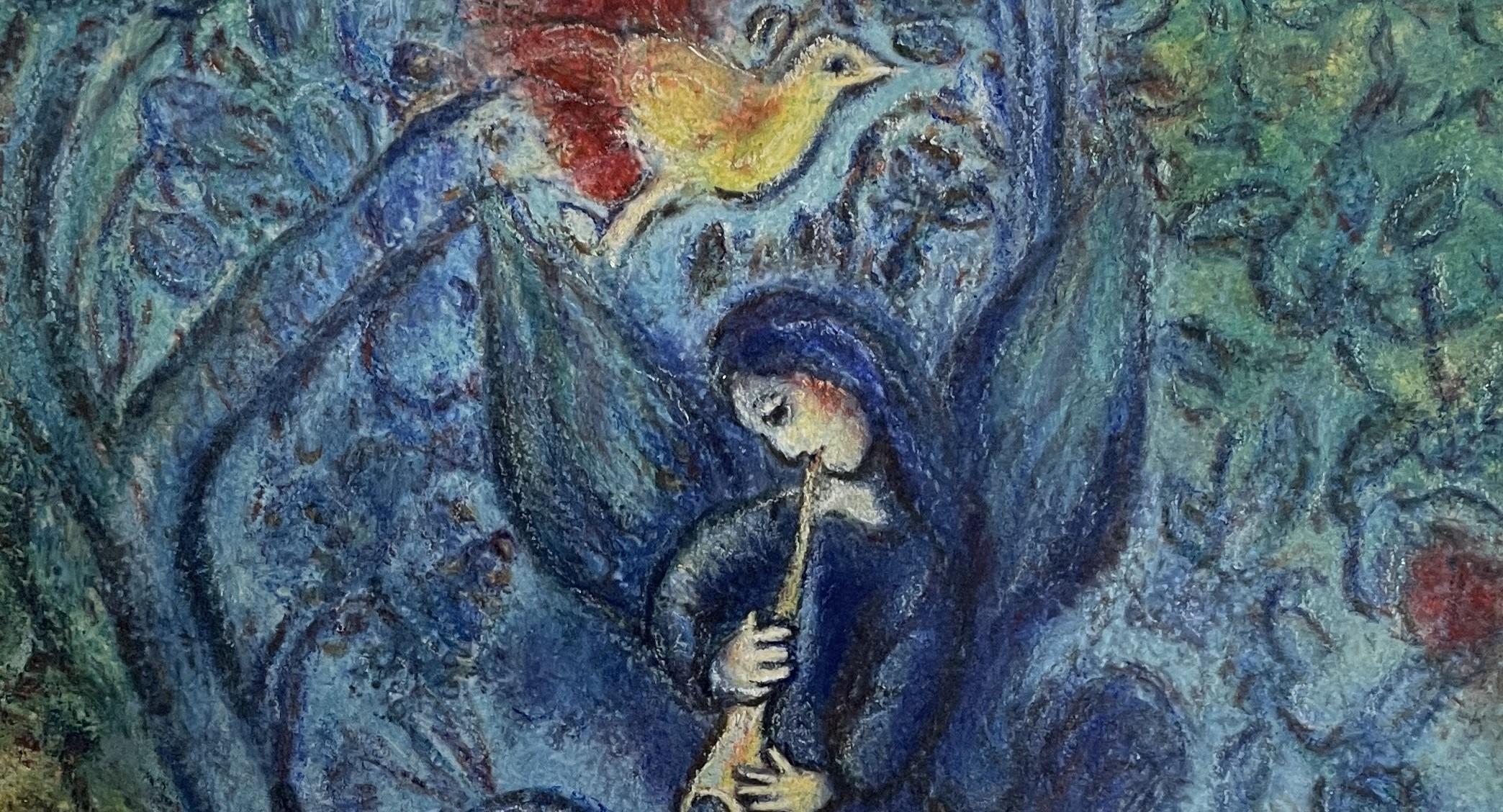日本語-Englishー台灣華語
ポール・セザンヌ「洋梨のある静物」

Still Life with Apples and Pears
梨與靜物
セザンヌの絵は私には未だに謎だ。セザンヌが何故あれほど評価されているのか、どうにもわからない。セザンヌについて書いた美術評論を読むたびに失望する。どれを読んでも肝心な事になると今一つあやふやだ。本当は良さがわかっていない裸の王様ばかりなのではないかと思えてくる。セザンヌ展を観るたびに下手な絵だと思うばかりだ。
ところがそんなセザンヌの絵でも、そんな私でも、時々素晴らしいと思うことがあるからややこしい。水彩と水彩に限りなく近い薄塗りの油彩、それに一部の静物画には時々はっとさせられる。それでもやはりセザンヌは、基本的には下手な画家なのだと私は思う。下手な画家であるからこそ、偉大な画家になれたと言える位だ。セザンヌは絵にかける情熱と腕前が大きく乖離していることに絶えず苦悩していたと思う。そしてそれをねじ伏せて克服する術を絶えず模索していたに違いない。デッサンをしても目の前にある物を巧く表現できない自分に苛立ち、いっそのことデッサンと色を切り離さずに色彩で形をとらえはじめたのではないか。ある視点から絵を描きはじめても、どうしても立体感が出ない時に、視点をずらして描くことにより行き詰まりを打開したのではないか。全体を巧くまとめきれないからこそ、断片を積み重ねて全体を構成したのではないか。
それにしてもそんなセザンヌの静物画が、岸田劉生の素晴らしい静物画と同じように重く存在感のある絵になっているのは、どうしたことなのだろう。私は横浜の展覧会で出会った「洋梨のある静物」を描いてみることにした。 セザンヌはよほど人嫌いだったのか、人間の感情をとらえることがない。対象の個性が欠落した同じ人物画であっても、ドガの人物画には人間の美というものに対する眼差しがあるが、セザンヌの人物画には人間がそこに存在するだけで、感情がない。セザンヌの絵画にはロマンティックな要素が欠落している。セザンヌの人物画はどれもピンぼけの不機嫌な人たちばかりだ。ヌードにいたってはここまで下手にはなかなか描けないものだ。それなのにカルタをする人物には確たる存在感があるのはどうしたことか。ピンぼけの庭師が時々美しく見えるのはどうした訳なのだろう。いや人物画として見るからいけないのかもしれない。セザンヌにおいては風景画と人物画に差異がないのだ。対象は問題ではない。極端に言えば、対象は色面を組み立てるための方便にすぎない。樹木は様々な階調を持つ緑から構成されるが故に選ばれた対象にすぎず、山は色面がせめぎ合う量感のある完結した対象故に選ばれたにすぎない。
モネは風景に満ちている光の移ろいを色彩で表現できたが、セザンヌはモネを超えるために物の存在感を色彩の移ろいで表現しようとしたのだろう。視点をずらし、時間をずらせば形も色も違った感じに見えるものだが、きっとセザンヌにはひとたび選んだどんな対象も、描くたびに違って見えたに相違ない。セザンヌはそれを是認しながら、違った色と歪んだ形に調和をもたらすのに苦悩しながら絵を描いたのだ。セザンヌの絵は一瞬一瞬の感覚が積み重なってできているのだ。とかくバラバラになりがちな色彩と色彩をつなぎ合わせるために、セザンヌは全体に青系統の色を使っているかのようだ。それはちょうど、自然に空気が満ちているように、レオナルドの空気遠近法が全体に青みを帯びているように。青い色は心の苛立ちを静め、まとまった感覚を画面に与えてくれる。
それにしても自然に即して絵を描くと言ったセザンヌが、なぜ筆致のリズムにこだわったのか。それが画家独自の感覚を表現するための技法なのだろうが、同じ方向に重なり合うように描くのはどうしてなのだろう。セザンヌの絵を模写するのはとても難しい。まだ当分は謎のままだろう。
私のセザンヌはとてもひどいままだ。いずれあなたをわかる時が来るのが楽しみだ。 ピカソのように対象を易々と写しとれる人間には、対極のルソーやセザンヌがなぜ素晴らしい絵を描けるのか興味があったに違いない。ゴーギャンのように様々な画家の技法を取り込み、独自の画風に再構成しようとする画家にとっては、セザンヌの絵画革新への試みは大いに参考になったはずだ。困難に挑み生涯苦悩していたセザンヌが、マティスにとって救いであったように、得体が知れないセザンヌがいてくれることは、私にとって仕合せなことだ。
Still Life with Apples and Pears
Cézanne’s paintings are still a mystery to me. I can’t understand why he is so highly regarded. Every time I read an art critique about Cézanne, I end up disappointed. No matter which one I read, when it comes to the crucial points, they all seem vague. It starts to feel like they are all just emperors with no clothes, not truly understanding his greatness. Every time I see a Cézanne exhibition, I just think the paintings are poor. Yet, it’s complicated because sometimes, even I think they are wonderful. His watercolors and thinly applied oils, along with some of his still life, occasionally take my breath away. Still, I fundamentally consider Cézanne to be a poor painter. Perhaps it is precisely because he was a poor painter that he could become a great one. I believe he was constantly tormented by the vast gap between his passion for painting and his skill. He must have been constantly searching for ways to overcome and subdue this struggle. Frustrated that he couldn’t accurately express what was right in front of him through drawing, he perhaps began capturing forms with color without separating drawing and color. Maybe when he couldn’t achieve a sense of depth from one viewpoint, shifting perspectives helped him break through the impasse. Unable to neatly tie everything together, he might have constructed wholes from assembling fragments. Yet, it’s curious how Cézanne’s still life can have the same heavy presence and significance as the wonderful still life by Ryusei Kishida. I decided to try painting “Still Life with Apples” after encountering it at an exhibition in Yokohama.
Cézanne must have been quite a misanthrope, never capturing human emotions. Even his portraits, devoid of the subject’s individuality, lack the gaze upon human beauty that Degas’ portraits have; Cézanne’s figures merely exist, emotionless. His paintings lack romantic elements. His portraits are unfocused, grumpy people. His nudes are so poorly done it’s remarkable. Yet, there’s a definite presence in his paintings of card players. How can his blurry gardener occasionally appear beautiful? Perhaps the mistake is in viewing them as portraits. For Cézanne, there’s no difference between landscapes and portraits. The subject is not the issue. To put it extremely, subjects are merely conveniences for assembling color planes. Trees are chosen subjects because of their various shades of green, and mountains are chosen for the volumetric tension of their color planes.
Monet was able to express the shifting light in landscapes through color, but Cézanne must have aimed to surpass Monet by expressing the presence of objects through the transition of colors. Changing perspectives and timing, forms and colors must have appeared differently to Cézanne every time he chose a subject. While acknowledging this, Cézanne struggled to bring harmony to different colors and distorted shapes as he painted. Cézanne’s paintings are composed of accumulated moments of sensation. To connect disparate colors, Cézanne seems to have used a palette dominated by blues throughout, much like nature is filled with air or Leonardo’s aerial perspective imbues the entire scene with a bluish tint. The blue calms the agitation of the heart and brings a cohesive sensation to the canvas. Nonetheless, it’s intriguing that Cézanne, who spoke of painting directly from nature, focused on the rhythm of brushstrokes. This technique was probably a means of expressing the painter’s unique sensation, but why paint in overlapping directions? Replicating Cézanne’s paintings is incredibly difficult. The mystery remains, for now. My Cézanne is still terrible. I look forward to the day I can understand him.
For someone like Picasso, who could easily capture subjects, the question of why painters at the opposite spectrum, like Rousseau or Cézanne, could create wonderful paintings must have been intriguing. For painters like Gauguin, who absorbed various techniques from different artists and reconstituted them into their own style, Cézanne’s attempts at painting innovation would have been greatly informative. The fact that Cézanne, who faced difficulties and suffered throughout his life, existed is a comfort to me, much like he was for Matisse. It’s a happy circumstance to have such an enigmatic figure like Cézanne.
保羅·塞尚《梨與靜物》
塞尚的畫對我來說仍是個謎。為什麼塞尚會被如此高度評價,我實在是搞不懂。每次讀到關於塞尚的藝術評論,我都感到失望。無論讀哪一篇,到了關鍵處總是模糊不清。我開始懷疑,這些人是否都像裸王一樣,其實並不真正理解其價值。每當我看到塞尚的展覽,我總是覺得那些畫作技術拙劣。
然而,即使是這樣的塞尚畫作,有時候我卻會覺得它們非常精彩。限於水彩和近乎水彩的淡彩油畫,以及其中一些靜物畫,有時真的會讓人眼前一亮。但我仍然認為,塞尚基本上是一位技術拙劣的畫家。正是因為他的技術不佳,他才能成為偉大的畫家。我認為塞尚一直在苦苦掙扎,因為他對畫畫的熱情和技巧之間存在著巨大的鴻溝。他一定是不斷地尋找克服這種困境的方法。或許他因為無法準確表達眼前的物體而感到挫折,於是就開始嘗試不將素描與色彩分離,用色彩來捕捉形態。當他從某一視角開始畫畫,卻無法表現出立體感時,可能就通過改變視角來突破僵局。因為無法將整體巧妙地組合在一起,所以他可能就通過堆疊片段來構建整體。儘管如此,塞尚的靜物畫仍然能夠像岸田劉生的精美靜物畫一樣,具有強烈的存在感,這是怎麼回事呢?我決定嘗試繪製我在橫濱展覽會上遇到的《梨與靜物》。
塞尚或許非常討厭人,從不捕捉人的情感。即便是缺乏個性的同一人物畫,德加的作品中還能看到對人類之美的凝視,但塞尚的人物畫中,人僅僅是存在,毫無情感。塞尚的畫作缺少浪漫元素。他的人物畫全部都是焦躁不安的模糊形象。至於裸體畫,難得有人能畫得這麼拙劣。然而,那些玩牌的人物卻有著明確的存在感,這是為什麼呢?模糊的園丁偶爾看起來竟然美麗,這又是為了什麼呢?也許是因為從人物畫的角度來看問題不對。對塞尚來說,風景畫和人物畫之間沒有差別。對象不是問題。極端來說,對象不過是組建色彩面的方便之物。樹木因其多樣的綠色階調而被選中,山因其色彩面的量感互相碰撞而成為完整的對象。
莫內能夠用色彩表現風景中光的變化,塞尚想要超越莫內,通過色彩的變化表現物體的存在感。如果視角和時間發生變化,形狀和顏色看起來也會不同,對塞尚來說,任何一次選擇的對象,在每次繪畫時都會看起來不同。塞尚在接受這一點的同時,也在苦苦掙扎著,試圖在不同的顏色和扭曲的形狀中找到和諧。塞尚的畫是一瞬間感覺的積累。為了將彼此可能分散的色彩連接起來,塞尚似乎在整體上使用了藍色系。這就像自然界充滿空氣一樣,達文西的空氣透視法讓整體呈現藍色。藍色能夠平息心中的焦躁,給畫面帶來統一的感覺。然而,塞尚為什麼堅持在筆觸的節奏上呢?這可能是為了表達畫家獨特的感覺的技巧,但為什麼要選擇以相同方向重疊的方式來繪畫呢?模仿塞尚的畫非常困難。或許這個謎還要一段時間才能解開。我的塞尚作品仍然很糟糕。我期待有一天能夠理解你。
像畢加索那樣能夠輕易捕捉對象的人,一定對塞尚或盧梭這樣能夠創作出精彩畫作的畫家感到好奇。對於像高更那樣吸收多種畫家技法並重新構建獨特畫風的畫家來說,塞尚對畫畫創新的嘗試無疑提供了很多參考。對於終其一生都在面對困難和苦惱的塞尚來說,他對馬蒂斯來說就像是一種救贖,對我來說,有一個如此難以捉摸的塞尚存在,是一件幸福的事。

